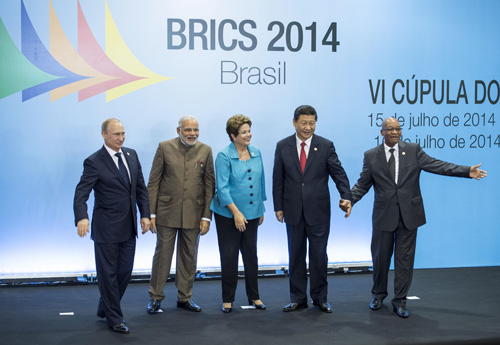|
 |
|
BUILDING WITH BRICS: Leaders of the BRICS countries--Brazil, Russia, India, China and South Africa--attend the group's annual summit in Fortaleza, Brazil, on July 15, 2014, where they agreed to launch the New Development Bank and the Contingent Reserve Arrangement for the world's major emerging economies (WANG YE) |
Looking back at the state of the world last year, both conventional and nonconventional security threats posed challenges globally. Influenced by confrontation between powers, some regions fell into the chaos of conflict. Meanwhile, the comprehensive strength of emerging economies and developing countries continued to rise.
Slow uptrend
The global economic rebound was weak in 2014, suggesting that the world could be stuck in a sluggish growth rut for a long time. According to the World Economic Outlook report released by the International Monetary Fund (IMF) last October, the growth forecast for the world economy in 2014 was 3.3 percent, the same level as in 2013. Its forecast for global trade growth in 2014 stood at 3.1 percent, only slightly higher than in the previous year. Both of the figures are lower than those prior to 2008.
The IMF report stated that the growth rate for developed economies was expected to be 1.8 percent in 2014. The GDP growth for the United States, for example, has been estimated at 2.2 percent. Emerging markets and developing economies as a whole were reported to have produced stronger growth with an average of 4.4 percent last year. China, as the world's largest developing country, would register a GDP growth with 7.4 percent—lower than in previous years. The United States and China are the two most important economic powerhouses in the world.
Developed economies have taken a different approach in terms of recovery. The U.S. Federal Reserve ended its quantitative easing (QE) stimulus in October 2014, declaring an effective economic recovery. The EU and Japan are considering more QE measures to cope with their respective economic recessions, registering growth rates of 0.9 percent for the EU and 0.8 percent for Japan.
Brazil, Russia, India, China and South Africa—members of the BRICS club of major emerging economies—have made efforts of their own to address economic challenges. China and India maintained highspeed economic development last year, with the latter's growth rate reaching 5.6 percent. Brazil and Russia are struggling with a number of problems, including stagflation, currency devaluation and capital loss. The two countries' growth rates in 2014 stood at 0.3 percent and 0.5 percent, respectively.
The overall growth speed for developing economies in 2014 was 0.3 percent lower than in the same period a year earlier, and that figure has remained less than 5 percent for three consecutive years. Their growth rate is expected to bounce back to 5 percent in 2015-18, but is unlikely to repeat the 7 percent between 2003 and 2007, according to the IMF. The slowing growth of developing economies could become a "new normal." Despite their economic slowdown, developing economies as a whole are still growing faster than developed ones, and are nonetheless playing an increasingly important role in driving the world economy.
Against the backdrop of a sluggish trend, both developed and developing economies have chosen to pursue growth through economic restructuring, industrial transformation and innovation. For example, the United States planned to establish eight innovation centers to promote reindustrialization of its manufacturing sector.
Developing new international cooperation mechanisms is also a valuable objective for many countries. Free trade was featured as a major agenda item for many multilateral meetings in 2014. At present, the negotiation for the United States-led Trans-Pacific Partnership trade agreement has made substantial progress. Other significant free trade talks are advancing on schedule in the Asia-Pacific region, namely the Regional Comprehensive Economic Partnership, initiated by the Association of Southeast Asian Nations.
Leaders reached broad consensus at the 22nd Asia-Pacific Economic Cooperation Economic Leaders' Meeting in Beijing on November 5-11, 2014, in terms of advancing regional economic integration, promoting innovative development, economic reform and growth as well as strengthening connectivity and infrastructure development.
As for global governance, leaders of the Group of 20 (G20) promised to work together to lift growth, boost economic resilience and strengthen global institutions at the summit held in Brisbane, Australia, on November 15- 16, 2014.
G20 leaders in 2010 agreed upon a reform package of the IMF that will give emerging economies greater voting power. However, the United States, which is the largest stakeholder at the institution, has failed to ratify it due to opposition by the U.S. Congress. The efforts by some U.S. politicians to protect the country's global financial hegemony suggest that the process of reforming the international financial system remain arduous.
|
